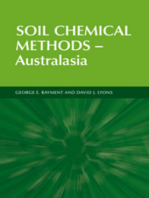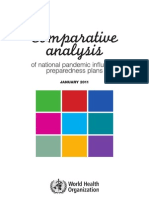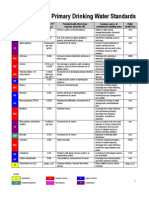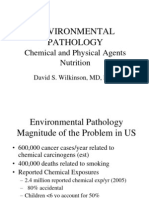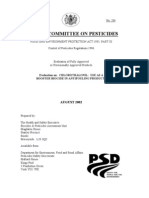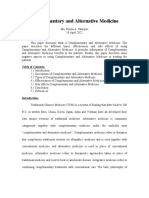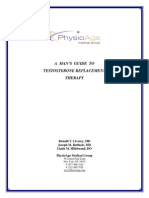Us Epa 2009
Us Epa 2009
Uploaded by
MafaldoJFCopyright:
Available Formats
Us Epa 2009
Us Epa 2009
Uploaded by
MafaldoJFOriginal Description:
Original Title
Copyright
Available Formats
Share this document
Did you find this document useful?
Is this content inappropriate?
Copyright:
Available Formats
Us Epa 2009
Us Epa 2009
Uploaded by
MafaldoJFCopyright:
Available Formats
National Primary Drinking Water Regulations
Contaminant MCL or Potential health effects from Common sources of contaminant Public Health
TT1 (mg/L)2 long-term3 exposure above the MCL in drinking water Goal (mg/L)2
OC Acrylamide TT4 Nervous system or blood problems; Added to water during sewage/ zero
increased risk of cancer wastewater treatment
OC Alachlor 0.002 Eye, liver, kidney or spleen problems; Runoff from herbicide zero
anemia; increased risk of cancer used on row crops
R Alpha/photon emitters 15 picocuries Increased risk of cancer Erosion of natural deposits of certain zero
per Liter minerals that are radioactive and
(pCi/L) may emit a form of radiation known
as alpha radiation
IOC Antimony 0.006 Increase in blood cholesterol; decrease Discharge from petroleum refineries; 0.006
in blood sugar fire retardants; ceramics; electronics;
solder
IOC Arsenic 0.010 Skin damage or problems with circulatory Erosion of natural deposits; runoff 0
systems, and may have increased from orchards; runoff from glass &
risk of getting cancer electronics production wastes
IOC Asbestos (fibers >10 7 million Increased risk of developing benign Decay of asbestos cement in water 7 MFL
micrometers) fibers per intestinal polyps mains; erosion of natural deposits
Liter (MFL)
OC Atrazine 0.003 Cardiovascular system or reproductive Runoff from herbicide used on row 0.003
problems crops
IOC Barium 2 Increase in blood pressure Discharge of drilling wastes; discharge 2
from metal refineries; erosion
of natural deposits
OC Benzene 0.005 Anemia; decrease in blood platelets; Discharge from factories; leaching zero
increased risk of cancer from gas storage tanks and landfills
OC Benzo(a)pyrene 0.0002 Reproductive difficulties; increased risk Leaching from linings of water storage zero
(PAHs) of cancer tanks and distribution lines
IOC Beryllium 0.004 Intestinal lesions Discharge from metal refineries and 0.004
coal-burning factories; discharge
from electrical, aerospace, and
defense industries
R Beta photon emitters 4 millirems Increased risk of cancer Decay of natural and man-made zero
per year deposits of certain minerals that are
radioactive and may emit forms of
radiation known as photons and beta
radiation
DBP Bromate 0.010 Increased risk of cancer Byproduct of drinking water disinfection zero
IOC Cadmium 0.005 Kidney damage Corrosion of galvanized pipes; erosion 0.005
of natural deposits; discharge
from metal refineries; runoff from
waste batteries and paints
OC Carbofuran 0.04 Problems with blood, nervous system, or Leaching of soil fumigant used on rice 0.04
reproductive system and alfalfa
OC Carbon tetrachloride 0.005 Liver problems; increased risk of cancer Discharge from chemical plants and zero
other industrial activities
D Chloramines (as Cl2) MRDL=4.01 Eye/nose irritation; stomach discomfort; Water additive used to control MRDLG=41
anemia microbes
OC Chlordane 0.002 Liver or nervous system problems; Residue of banned termiticide zero
increased risk of cancer
D Chlorine (as Cl2) MRDL=4.01 Eye/nose irritation; stomach discomfort Water additive used to control MRDLG=41
microbes
D Chlorine dioxide MRDL=0.81 Anemia; infants, young children, and fetuses of Water additive used to control MRDLG=0.81
(as ClO2) pregnant women: nervous system effects microbes
DBP Chlorite 1.0 Anemia; infants, young children, and fetuses of Byproduct of drinking water 0.8
pregnant women: nervous system effects disinfection
OC Chlorobenzene 0.1 Liver or kidney problems Discharge from chemical and agricultural 0.1
chemical factories
IOC Chromium (total) 0.1 Allergic dermatitis Discharge from steel and pulp mills; 0.1
erosion of natural deposits
IOC Copper TT5; Short-term exposure: Gastrointestinal Corrosion of household plumbing 1.3
Action distress. Long-term exposure: Liver or systems; erosion of natural deposits
Level = kidney damage. People with Wilsons
1.3 Disease should consult their personal
doctor if the amount of copper in their
water exceeds the action level
M Cryptosporidium TT7 Short-term exposure: Gastrointestinal illness Human and animal fecal waste zero
(e.g., diarrhea, vomiting, cramps)
LEGEND
D Disinfectant IOC Inorganic Chemical OC Organic Chemical
DBP Disinfection Byproduct M Microorganism R Radionuclides
Contaminant MCL or Potential health effects from Common sources of contaminant Public Health
TT1 (mg/L)2 long-term3 exposure above the MCL in drinking water Goal (mg/L)2
IOC Cyanide 0.2 Nerve damage or thyroid problems Discharge from steel/metal factories; 0.2
(as free cyanide) discharge from plastic and fertilizer
factories
OC 2,4-D 0.07 Kidney, liver, or adrenal gland problems Runoff from herbicide used on row 0.07
crops
OC Dalapon 0.2 Minor kidney changes Runoff from herbicide used on rights 0.2
of way
OC 1,2-Dibromo-3- 0.0002 Reproductive difficulties; increased risk Runoff/leaching from soil fumigant zero
chloropropane of cancer used on soybeans, cotton, pineapples,
(DBCP) and orchards
OC o-Dichlorobenzene 0.6 Liver, kidney, or circulatory system Discharge from industrial chemical 0.6
problems factories
OC p-Dichlorobenzene 0.075 Anemia; liver, kidney or spleen damage; Discharge from industrial chemical 0.075
changes in blood factories
OC 1,2-Dichloroethane 0.005 Increased risk of cancer Discharge from industrial chemical zero
factories
OC 1,1-Dichloroethylene 0.007 Liver problems Discharge from industrial chemical 0.007
factories
OC cis-1,2-Dichloroethylene 0.07 Liver problems Discharge from industrial chemical 0.07
factories
OC trans-1,2 0.1 Liver problems Discharge from industrial chemical 0.1
Dichloroethylene factories
OC Dichloromethane 0.005 Liver problems; increased risk of cancer Discharge from drug and chemical zero
factories
OC 1,2-Dichloropropane 0.005 Increased risk of cancer Discharge from industrial chemical zero
factories
OC Di(2-ethylhexyl) adipate 0.4 Weight loss, liver problems, or possible Discharge from chemical factories 0.4
reproductive difficulties
OC Di(2-ethylhexyl) 0.006 Reproductive difficulties; liver problems; Discharge from rubber and chemical zero
phthalate increased risk of cancer factories
OC Dinoseb 0.007 Reproductive difficulties Runoff from herbicide used on soybeans 0.007
and vegetables
OC Dioxin (2,3,7,8-TCDD) 0.00000003 Reproductive difficulties; increased risk Emissions from waste incineration zero
of cancer and other combustion; discharge
from chemical factories
OC Diquat 0.02 Cataracts Runoff from herbicide use 0.02
OC Endothall 0.1 Stomach and intestinal problems Runoff from herbicide use 0.1
OC Endrin 0.002 Liver problems Residue of banned insecticide 0.002
OC Epichlorohydrin TT4 Increased cancer risk; stomach problems Discharge from industrial chemical zero
factories; an impurity of some water
treatment chemicals
OC Ethylbenzene 0.7 Liver or kidney problems Discharge from petroleum refineries 0.7
OC Ethylene dibromide 0.00005 Problems with liver, stomach, reproductive Discharge from petroleum refineries zero
system, or kidneys; increased risk of cancer
M Fecal coliform and MCL6 Fecal coliforms and E. coli are bacteria whose Human and animal fecal waste zero6
E. coli presence indicates that the water may be contaminated
with human or animal wastes. Microbes in these wastes
may cause short term effects, such as diarrhea, cramps,
nausea, headaches, or other symptoms. They may pose a
special health risk for infants, young children, and people
with severely compromised immune systems.
IOC Fluoride 4.0 Bone disease (pain and tenderness of Water additive which promotes 4.0
the bones); children may get mottled strong teeth; erosion of natural
teeth deposits; discharge from fertilizer
and aluminum factories
M Giardia lamblia TT7 Short-term exposure: Gastrointestinal illness Human and animal fecal waste zero
(e.g., diarrhea, vomiting, cramps)
OC Glyphosate 0.7 Kidney problems; reproductive Runoff from herbicide use 0.7
difficulties
DBP Haloacetic acids 0.060 Increased risk of cancer Byproduct of drinking water n/a9
(HAA5) disinfection
OC Heptachlor 0.0004 Liver damage; increased risk of cancer Residue of banned termiticide zero
OC Heptachlor epoxide 0.0002 Liver damage; increased risk of cancer Breakdown of heptachlor zero
M Heterotrophic plate TT 7
HPC has no health effects; it is an HPC measures a range of bacteria n/a
count (HPC) analytic method used to measure the that are naturally present in the
variety of bacteria that are common in environment
water. The lower the concentration of
bacteria in drinking water, the better
maintained the water system is.
LEGEND
D Disinfectant IOC Inorganic Chemical OC Organic Chemical
DBP Disinfection Byproduct M Microorganism R Radionuclides
Contaminant MCL or Potential health effects from Common sources of contaminant Public Health
TT1 (mg/L)2 long-term3 exposure above the MCL in drinking water Goal (mg/L)2
OC Hexachlorobenzene 0.001 Liver or kidney problems; reproductive Discharge from metal refineries and zero
difficulties; increased risk of cancer agricultural chemical factories
OC Hexachlorocyclopentadiene 0.05 Kidney or stomach problems Discharge from chemical factories 0.05
IOC Lead TT5; Infants and children: Delays in physical or Corrosion of household plumbing zero
Action or mental development; children could systems; erosion of natural deposits
Level=0.015 show slight deficits in attention span
and learning abilities; Adults: Kidney
problems; high blood pressure
M Legionella TT7 Legionnaires Disease, a type of Found naturally in water; multiplies in zero
pneumonia heating systems
OC Lindane 0.0002 Liver or kidney problems Runoff/leaching from insecticide used 0.0002
on cattle, lumber, gardens
IOC Mercury (inorganic) 0.002 Kidney damage Erosion of natural deposits; discharge 0.002
from refineries and factories;
runoff from landfills and croplands
OC Methoxychlor 0.04 Reproductive difficulties Runoff/leaching from insecticide used 0.04
on fruits, vegetables, alfalfa, livestock
IOC Nitrate (measured as 10 Infants below the age of six months who Runoff from fertilizer use; leaching 10
Nitrogen) drink water containing nitrate in excess from septic tanks, sewage; erosion of
of the MCL could become seriously ill natural deposits
and, if untreated, may die. Symptoms
include shortness of breath and blue-baby
syndrome.
IOC Nitrite (measured as 1 Infants below the age of six months who Runoff from fertilizer use; leaching 1
Nitrogen) drink water containing nitrite in excess from septic tanks, sewage; erosion of
of the MCL could become seriously ill natural deposits
and, if untreated, may die. Symptoms
include shortness of breath and blue-baby
syndrome.
OC Oxamyl (Vydate) 0.2 Slight nervous system effects Runoff/leaching from insecticide used 0.2
on apples, potatoes, and tomatoes
OC Pentachlorophenol 0.001 Liver or kidney problems; increased Discharge from wood-preserving zero
cancer risk factories
OC Picloram 0.5 Liver problems Herbicide runoff 0.5
OC Polychlorinated biphenyls 0.0005 Skin changes; thymus gland problems; Runoff from landfills; discharge of zero
(PCBs) immune deficiencies; reproductive or waste chemicals
nervous system difficulties; increased
risk of cancer
R Radium 226 and 5 pCi/L Increased risk of cancer Erosion of natural deposits zero
Radium 228 (combined)
IOC Selenium 0.05 Hair or fingernail loss; numbness in fingers Discharge from petroleum and metal refineries; 0.05
or toes; circulatory problems erosion of natural deposits; discharge
from mines
OC Simazine 0.004 Problems with blood Herbicide runoff 0.004
OC Styrene 0.1 Liver, kidney, or circulatory system problems Discharge from rubber and plastic 0.1
factories; leaching from landfills
OC Tetrachloroethylene 0.005 Liver problems; increased risk of cancer Discharge from factories and dry cleaners zero
IOC Thallium 0.002 Hair loss; changes in blood; kidney, intestine, Leaching from ore-processing sites; 0.0005
or liver problems discharge from electronics, glass,
and drug factories
OC Toluene 1 Nervous system, kidney, or liver problems Discharge from petroleum factories 1
M Total Coliforms 5.0 Coliforms are bacteria that indicate that other, Naturally present in the environment zero
percent8 potentially harmful bacteria may be present.
See fecal coliforms and E. coli
DBP Total Trihalomethanes 0.080 Liver, kidney or central nervous system problems; Byproduct of drinking water disinfection n/a9
(TTHMs) increased risk of cancer
OC Toxaphene 0.003 Kidney, liver, or thyroid problems; Runoff/leaching from insecticide used zero
increased risk of cancer on cotton and cattle
OC 2,4,5-TP (Silvex) 0.05 Liver problems Residue of banned herbicide 0.05
OC 1,2,4-Trichlorobenzene 0.07 Changes in adrenal glands Discharge from textile finishing 0.07
factories
OC 1,1,1-Trichloroethane 0.2 Liver, nervous system, or circulatory Discharge from metal degreasing 0.2
problems sites and other factories
OC 1,1,2-Trichloroethane 0.005 Liver, kidney, or immune system Discharge from industrial chemical 0.003
problems factories
OC Trichloroethylene 0.005 Liver problems; increased risk of cancer Discharge from metal degreasing zero
sites and other factories
LEGEND
D Disinfectant IOC Inorganic Chemical OC Organic Chemical
DBP Disinfection Byproduct M Microorganism R Radionuclides
Contaminant MCL or Potential health effects from Common sources of contaminant Public Health
TT1 (mg/L)2 long-term3 exposure above the MCL in drinking water Goal (mg/L)2
M Turbidity TT7 Turbidity is a measure of the cloudiness of water. Soil runoff n/a
It is used to indicate water quality and filtration
effectiveness (e.g., whether disease-causing organisms
are present). Higher turbidity levels are often associated
with higher levels of disease-causing microorganisms
such as viruses, parasites and some bacteria. These
organisms can cause short term symptoms such as
nausea, cramps, diarrhea, and associated headaches.
R Uranium 30g/L Increased risk of cancer, kidney toxicity Erosion of natural deposits zero
OC Vinyl chloride 0.002 Increased risk of cancer Leaching from PVC pipes; discharge zero
from plastic factories
M Viruses (enteric) TT7 Short-term exposure: Gastrointestinal illness Human and animal fecal waste zero
(e.g., diarrhea, vomiting, cramps)
OC Xylenes (total) 10 Nervous system damage Discharge from petroleum factories; 10
discharge from chemical factories
LEGEND
D Disinfectant IOC Inorganic Chemical OC Organic Chemical
DBP Disinfection Byproduct M Microorganism R Radionuclides
NOTES
1 Definitions
Maximum Contaminant Level Goal (MCLG)The level of a contaminant in drinking water below
Viruses: 99.99 percent removal/inactivation
which there is no known or expected risk to health. MCLGs allow for a margin of safety and are
Legionella: No limit, but EPA believes that if Giardia and viruses are removed/inactivated according
non-enforceable public health goals. to the treatment techniques in the surface water treatment rule, Legionella will also be controlled.
Maximum Contaminant Level (MCL)The highest level of a contaminant that is allowed in
Turbidity: For systems that use conventional or direct filtration, at no time can turbidity (cloudiness of
drinking water. MCLs are set as close to MCLGs as feasible using the best available treatment water) go higher than 1 nephelolometric turbidity unit (NTU), and samples for turbidity must be
technology and taking cost into consideration. MCLs are enforceable standards. less than or equal to 0.3 NTU in at least 95 percent of the samples in any month. Systems that use
Maximum Residual Disinfectant Level Goal (MRDLG)The level of a drinking water disinfectant filtration other than conventional or direct filtration must follow state limits, which must include turbidity
below which there is no known or expected risk to health. MRDLGs do not reflect the benefits of at no time exceeding 5 NTU.
the use of disinfectants to control microbial contaminants.
HPC: No more than 500 bacterial colonies per milliliter
Maximum Residual Disinfectant Level (MRDL)The highest level of a disinfectant allowed in
Long Term 1 Enhanced Surface Water Treatment; Surface water systems or ground water systems
drinking water. There is convincing evidence that addition of a disinfectant is necessary for under the direct influence of surface water serving fewer than 10,000 people must comply with the
control of microbial contaminants. applicable Long Term 1 Enhanced Surface Water Treatment Rule provisions (e.g. turbidity standards,
Treatment Technique (TT)A required process intended to reduce the level of a contaminant in individual filter monitoring, Cryptosporidium removal requirements, updated watershed control
drinking water. requirements for unfiltered systems).
2 Units are in milligrams per liter (mg/L) unless otherwise noted. Milligrams per liter are equivalent
Long Term 2 Enhanced Surface Water Treatment; This rule applies to all surface water systems
to parts per million (ppm). or ground water systems under the direct influence of surface water. The rule targets additional
3 Health effects are from long-term exposure unless specified as short-term exposure. Cryptosporidium treatment requirements for higher risk systems and includes provisions to reduce
4 Each water system must certify annually, in writing, to the state (using third-party or manufacturers risks from uncovered finished water storages facilities and to ensure that the systems maintain microbial
certification) that when it uses acrylamide and/or epichlorohydrin to treat water, the combination (or protection as they take steps to reduce the formation of disinfection byproducts. (Monitoring
product) of dose and monomer level does not exceed the levels specified, as follows: Acrylamide start dates are staggered by system size. The largest systems (serving at least 100,000
= 0.05 percent dosed at 1 mg/L (or equivalent); Epichlorohydrin = 0.01 percent dosed at 20 mg/L people) will begin monitoring in October 2006 and the smallest systems (serving fewer than
(or equivalent). 10,000 people) will not begin monitoring until October 2008. After completing monitoring and
5 Lead and copper are regulated by a Treatment Technique that requires systems to control the determining their treatment bin, systems generally have three years to comply with any additional
corrosiveness of their water. If more than 10 percent of tap water samples exceed the action level, treatment requirements.)
water systems must take additional steps. For copper, the action level is 1.3 mg/L, and for lead is Filter Backwash Recycling: The Filter Backwash Recycling Rule requires systems that recycle to
0.015 mg/L. return specific recycle flows through all processes of the systems existing conventional or direct
6 A routine sample that is fecal coliform-positive or E. coli-positive triggers repeat samples--if any filtration system or at an alternate location approved by the state.
repeat sample is total coliform-positive, the system has an acute MCL violation. A routine sample 8 No more than 5.0 percent samples total coliform-positive in a month. (For water systems that collect
that is total coliform-positive and fecal coliform-negative or E. coli-negative triggers repeat samples--if fewer than 40 routine samples per month, no more than one sample can be total coliform-positive
any repeat sample is fecal coliform-positive or E. coli-positive, the system has an acute MCL violation. per month.) Every sample that has total coliform must be analyzed for either fecal coliforms or
See also Total Coliforms. E. coli. If two consecutive TC-positive samples, and one is also positive for E. coli or fecal coliforms,
7 EPAs surface water treatment rules require systems using surface water or ground water under system has an acute MCL violation.
the direct influence of surface water to (1) disinfect their water, and (2) filter their water or meet 9 Although there is no collective MCLG for this contaminant group, there are individual MCLGs for
criteria for avoiding filtration so that the following contaminants are controlled at the following levels: some of the individual contaminants:
Cryptosporidium: 99 percent removal for systems that filter. Unfiltered systems are required to Haloacetic acids: dichloroacetic acid (zero); trichloroacetic acid (0.3 mg/L)
include Cryptosporidium in their existing watershed control provisions. Trihalomethanes: bromodichloromethane (zero); bromoform (zero); dibromochloromethane (0.06 mg/L)
Giardia lamblia: 99.9 percent removal/inactivation
National Secondary Drinking
Water Regulation For More Information
National Secondary Drinking Water Regulations are non-enforceable guidelines regarding EPAs Safe Drinking Water Web site:
contaminants that may cause cosmetic effects (such as skin or tooth discoloration) or aes- http://www.epa.gov/safewater/
thetic effects (such as taste, odor, or color) in drinking water. EPA recommends secondary
standards to water systems but does not require systems to comply. However, some states
may choose to adopt them as enforceable standards.
EPAs Safe Drinking Water Hotline:
(800) 426-4791
Contaminant Secondary Maximum Contaminant Level
Aluminum 0.05 to 0.2 mg/L To order additional posters or other
Chloride 250 mg/L
Color 15 (color units) ground water and drinking water
Copper 1.0 mg/L publications, please contact the
Corrosivity noncorrosive National Service Center for
Fluoride 2.0 mg/L
Environmental Publications at :
Foaming Agents 0.5 mg/L
Iron 0.3 mg/L (800) 490-9198, or
Manganese 0.05 mg/L email: nscep@bps-lmit.com.
Odor 3 threshold odor number
pH 6.5-8.5
Silver 0.10 mg/L
Sulfate 250 mg/L
Total Dissolved Solids 500 mg/L
Zinc 5 mg/L
EPA 816-F-09-004
May 2009
You might also like
- Surgery Review QuestionsDocument44 pagesSurgery Review QuestionsHamza AhmedNo ratings yet
- Drinking Water RegulationsDocument6 pagesDrinking Water RegulationsRvnning WildNo ratings yet
- Comparative Analysis of National Pandemic Influenza Preparedness Plans - 2011Document64 pagesComparative Analysis of National Pandemic Influenza Preparedness Plans - 2011Mohamed WahbyNo ratings yet
- Distant Healing ManualDocument99 pagesDistant Healing ManualAmandaMMagaton100% (23)
- Drinking Water Standard EpaDocument6 pagesDrinking Water Standard EpaAnaly Baltodano MartínezNo ratings yet
- National Primary Drinking Water StandardsDocument4 pagesNational Primary Drinking Water Standardsari78No ratings yet
- National Primary Drinking Water StandardsDocument4 pagesNational Primary Drinking Water Standardsjeje87No ratings yet
- Safe Drinking Water Act & USEPA Regulations - AdrijaDocument19 pagesSafe Drinking Water Act & USEPA Regulations - AdrijaMamta GautamNo ratings yet
- 2013 Consumer Confidence ReportDocument6 pages2013 Consumer Confidence Reportapi-240608023No ratings yet
- Lepro Herbal Borewell Water Quality StandardsDocument5 pagesLepro Herbal Borewell Water Quality StandardssushantNo ratings yet
- Enviromental PathologyDocument35 pagesEnviromental PathologyAL-FARAH REHMAT ULLAHNo ratings yet
- Environmental and Nutrition DisordersDocument76 pagesEnvironmental and Nutrition Disordersrafay.nazar1234No ratings yet
- VOSS Water Quality ReportDocument6 pagesVOSS Water Quality ReportCA Deepak AgarwalNo ratings yet
- Water Pollutants Chemical DataDocument4 pagesWater Pollutants Chemical DataShivani PatelNo ratings yet
- Disinfection: Jae K. (Jim) Park, Professor Dept. of Civil and Environmental Engineering University of Wisconsin-MadisonDocument70 pagesDisinfection: Jae K. (Jim) Park, Professor Dept. of Civil and Environmental Engineering University of Wisconsin-MadisonChanel100% (2)
- Chlorine and CompoundDocument5 pagesChlorine and CompoundMegan LewisNo ratings yet
- Hazmat Lex1 (Anabeth Roble)Document78 pagesHazmat Lex1 (Anabeth Roble)Just singingNo ratings yet
- Water Quality Parameters - CcduDocument32 pagesWater Quality Parameters - CcduHarinder GroverNo ratings yet
- 2.water Quality PresentationDocument39 pages2.water Quality PresentationHailemariam FitsumNo ratings yet
- Tigard OR - Annual Water 2013Document8 pagesTigard OR - Annual Water 2013scribe500No ratings yet
- Dr. Evita - The Impact of Our Environtment and Microbiome On HealthDocument40 pagesDr. Evita - The Impact of Our Environtment and Microbiome On Healthwen jaNo ratings yet
- Ordnance Factory WorkshopDocument64 pagesOrdnance Factory Workshopamit@1No ratings yet
- Informational Water Quality Report (After)Document5 pagesInformational Water Quality Report (After)VirtualBizNo ratings yet
- Chlorine Dioxide, Ozone, Cold Plazma, Dense Phase Carbon Dioxide: Mechanism, Applications, TheoryDocument60 pagesChlorine Dioxide, Ozone, Cold Plazma, Dense Phase Carbon Dioxide: Mechanism, Applications, TheoryBüşra GültekinNo ratings yet
- Module - 2 Water Quality and ParametersDocument35 pagesModule - 2 Water Quality and ParametersEngr.Hamid Ismail CheemaNo ratings yet
- Informational Water Quality Report (Before)Document6 pagesInformational Water Quality Report (Before)VirtualBizNo ratings yet
- Titanium Advanced Oxidation Process (AOP) SystemDocument13 pagesTitanium Advanced Oxidation Process (AOP) Systemluis andradeNo ratings yet
- Eco Kinetics in Water: Created byDocument21 pagesEco Kinetics in Water: Created byTias Lika SariNo ratings yet
- 21 Water Quality & Water PollutionDocument64 pages21 Water Quality & Water PollutionAsif SaifiNo ratings yet
- Chemical and Physical Hazards in FoodDocument38 pagesChemical and Physical Hazards in FoodSAB MICHTITYANo ratings yet
- Tim Ber Ridge Subdivision: 2012 Annual DR Inking Water Quality Repor TDocument6 pagesTim Ber Ridge Subdivision: 2012 Annual DR Inking Water Quality Repor TcarleshiathorntonNo ratings yet
- MSD Standapol WAQ-LC PDFDocument8 pagesMSD Standapol WAQ-LC PDFarguijNo ratings yet
- Water ContaminationDocument8 pagesWater ContaminationQasim HabibNo ratings yet
- CCR 2015Document2 pagesCCR 2015api-234363692No ratings yet
- Toxicology (HDB 20803)Document17 pagesToxicology (HDB 20803)Nor Huzaimah Mohammed AlifNo ratings yet
- Water PolutionDocument55 pagesWater PolutionAdnan HasanNo ratings yet
- Drinking Water Report 2011Document2 pagesDrinking Water Report 2011Sachin JoshiNo ratings yet
- ES200WaterPollution L2Document37 pagesES200WaterPollution L2Ruchi Aayush MehtaNo ratings yet
- How To Interpret A Water Analysis Report: Agricultural and Biological EngineeringDocument4 pagesHow To Interpret A Water Analysis Report: Agricultural and Biological EngineeringjmastanaaNo ratings yet
- Heavy Metal: GW DW SW Crop S Fishes Food SDocument8 pagesHeavy Metal: GW DW SW Crop S Fishes Food SProsunNo ratings yet
- Am Pare1307 Okino PWDocument0 pagesAm Pare1307 Okino PWRudini SudewaNo ratings yet
- Lecture 5Document32 pagesLecture 5suvrotannu22No ratings yet
- Effects of Waterpollution On HealthDocument16 pagesEffects of Waterpollution On HealthNalluri Mallikarjuna RaoNo ratings yet
- Environmental Diseases, (PowerPoint File)Document49 pagesEnvironmental Diseases, (PowerPoint File)imtiazali2008No ratings yet
- Welcome To Your Water Treatment Practice ExamDocument9 pagesWelcome To Your Water Treatment Practice ExamTigst Tigst YzachewNo ratings yet
- Water Potability StandardsDocument4 pagesWater Potability StandardsBuenavista, John Edrin D.No ratings yet
- Water QualityDocument34 pagesWater QualitySarim ChNo ratings yet
- Advisory Committee On Pesticides: AUGUST 2002Document140 pagesAdvisory Committee On Pesticides: AUGUST 2002kalvarezrojasNo ratings yet
- Water Pollution: G. Tyler Miller's Living in The EnvironmentDocument22 pagesWater Pollution: G. Tyler Miller's Living in The EnvironmentMani ShankarNo ratings yet
- CH 2b Water Quality StandardsDocument5 pagesCH 2b Water Quality Standardssajinjunior1No ratings yet
- Biological Treatment of Drinking WaterDocument27 pagesBiological Treatment of Drinking WaterRendy PrakosoNo ratings yet
- 15 Human Health Effects of Heavy MetalsDocument6 pages15 Human Health Effects of Heavy MetalsKarla FountainsNo ratings yet
- Background: Vitec Aspida Limited, United KingdomDocument3 pagesBackground: Vitec Aspida Limited, United KingdomMạnh CườngNo ratings yet
- Copper: Health Information Summary: Health Effects Absorption/MetabolismDocument3 pagesCopper: Health Information Summary: Health Effects Absorption/MetabolismOmar ReynosoNo ratings yet
- Ecosys Chlorine Dioxide Presentasi PDFDocument36 pagesEcosys Chlorine Dioxide Presentasi PDFRichard RichardNo ratings yet
- ENVE 201 Week 2-3Document29 pagesENVE 201 Week 2-3Akbey ApaydınNo ratings yet
- 16.4.1 General Description: Identity Compound CAS No. Molecular FormulaDocument18 pages16.4.1 General Description: Identity Compound CAS No. Molecular FormulaEnrique GomezNo ratings yet
- Water Criteria STD N Pollution 03Document35 pagesWater Criteria STD N Pollution 03Harshal SabaneNo ratings yet
- Abg Disinfection FinalDocument53 pagesAbg Disinfection FinalPankaj SainiNo ratings yet
- Calcium Hypochlorite Sodium Hypochlorite: Division of Toxicology Toxfaqs April 2002Document2 pagesCalcium Hypochlorite Sodium Hypochlorite: Division of Toxicology Toxfaqs April 2002COMPASS LanguageAndskillsTrainingNo ratings yet
- Preventive TopicsDocument28 pagesPreventive TopicsTovin NguyenNo ratings yet
- Legally Poisoned: How the Law Puts Us at Risk from ToxicantsFrom EverandLegally Poisoned: How the Law Puts Us at Risk from ToxicantsNo ratings yet
- M. Wahby - Microbial ResourcesDocument37 pagesM. Wahby - Microbial ResourcesMohamed WahbyNo ratings yet
- Global Climate ChangeDocument285 pagesGlobal Climate ChangeMohamed Wahby100% (1)
- A Dictionary of Environmental EconomicsDocument417 pagesA Dictionary of Environmental Economics279259100% (2)
- Sewage Sludge Management in Egypt - Ghazy 2009Document9 pagesSewage Sludge Management in Egypt - Ghazy 2009Mohamed WahbyNo ratings yet
- Human Population PatternsDocument1 pageHuman Population PatternsMohamed WahbyNo ratings yet
- M. Wahby - Microbial ResourcesDocument37 pagesM. Wahby - Microbial ResourcesMohamed WahbyNo ratings yet
- Ipcc Far WG II Full ReportDocument273 pagesIpcc Far WG II Full ReportMohamed WahbyNo ratings yet
- Palynology of Mangrove Sediments in The Hamata Area, Red Sea Cost, Vegetation and Restoration OverviewDocument12 pagesPalynology of Mangrove Sediments in The Hamata Area, Red Sea Cost, Vegetation and Restoration OverviewMohamed WahbyNo ratings yet
- JCM 11 00699Document20 pagesJCM 11 00699OstazNo ratings yet
- Virology of Human Papillomavirus Infections and The Link To CancerDocument10 pagesVirology of Human Papillomavirus Infections and The Link To Canceralejandro fernandezNo ratings yet
- Complementary and Alternative MedicineDocument9 pagesComplementary and Alternative MedicineMa. Rejina PalacpacNo ratings yet
- (FREE PDF Sample) Textbook of Gastrointestinal Oncology Suayib Yalcin EbooksDocument49 pages(FREE PDF Sample) Textbook of Gastrointestinal Oncology Suayib Yalcin Ebookspypersthad100% (5)
- Humatrope 6 MG/ 12 MG/ 24 MG Powder and Solvent For Solution For InjectionDocument2 pagesHumatrope 6 MG/ 12 MG/ 24 MG Powder and Solvent For Solution For InjectionJames KobeNo ratings yet
- I. Listening Comprehension Section A Directions: in Section A, You Will Hear Ten Short Conversations Between Two Speakers. at The EndDocument10 pagesI. Listening Comprehension Section A Directions: in Section A, You Will Hear Ten Short Conversations Between Two Speakers. at The EndJayNo ratings yet
- Nursing Management Child With CancerDocument7 pagesNursing Management Child With CancerlisalovNo ratings yet
- HTTP Healthmedicinet Com II 2013 7 PDFDocument446 pagesHTTP Healthmedicinet Com II 2013 7 PDFtuni santeNo ratings yet
- Pregnancy in A Patient With Recurrent GlioblastomaDocument6 pagesPregnancy in A Patient With Recurrent GlioblastomaNoraNo ratings yet
- Brain ExercisesDocument19 pagesBrain Exercisesgodolfintorent100% (3)
- Rubi Li Vs Soliman, GR No. 165279Document1 pageRubi Li Vs Soliman, GR No. 165279El G. Se Cheng100% (1)
- Health Daily News Healthmedicinet 2024 04 13Document6 pagesHealth Daily News Healthmedicinet 2024 04 13tuni santeNo ratings yet
- TN MRB Auxiliary Nurse Midwife Exam SyllabusDocument4 pagesTN MRB Auxiliary Nurse Midwife Exam SyllabusmathanbhuNo ratings yet
- HCC - Improve CareDocument37 pagesHCC - Improve Caregiorgi popiashviliNo ratings yet
- Nursing Forum - 2024 - Ahmed - Risk Assessment Tool of Breast Cancer and Barriers Against Breast Self Examination AmongDocument13 pagesNursing Forum - 2024 - Ahmed - Risk Assessment Tool of Breast Cancer and Barriers Against Breast Self Examination Amongwafaa.ramadanNo ratings yet
- Tumor Marker (Book)Document5 pagesTumor Marker (Book)Who KnowsNo ratings yet
- Nano BotsDocument31 pagesNano Botspradeepagarwal62100% (1)
- A Man'S Guide To Testosterone Replacement TherapyDocument21 pagesA Man'S Guide To Testosterone Replacement TherapyEduardo NunesNo ratings yet
- Dandilion PowderDocument4 pagesDandilion PowderPablo DiscobarNo ratings yet
- Carolyn R. Zalameda-Castro, MDDocument9 pagesCarolyn R. Zalameda-Castro, MDeza floresNo ratings yet
- Block 5 (40) Female Reproductive System - Breast QsDocument42 pagesBlock 5 (40) Female Reproductive System - Breast QsJÓNATAN OSORIO PALACIONo ratings yet
- Research AlbinoDocument15 pagesResearch Albinozaldy albinoNo ratings yet
- Case StudyDocument1 pageCase StudyRhea PaduaNo ratings yet
- Oncology NursingDocument89 pagesOncology NursingRennard Christian J. De PerioNo ratings yet
- Kemo AnestesiDocument11 pagesKemo AnestesiHeru Fajar SyaputraNo ratings yet
- Safety Data Sheet: Chevron (Malaysia) Unleaded GasolineDocument12 pagesSafety Data Sheet: Chevron (Malaysia) Unleaded GasolineaminNo ratings yet
- Cgast 7 2014 033Document14 pagesCgast 7 2014 033Joakin RuedaNo ratings yet
- Diffuse Sclerosing Variant of Papillary Thyroid CarcinomaDocument2 pagesDiffuse Sclerosing Variant of Papillary Thyroid CarcinomaYAŞAR TÜRKNo ratings yet

